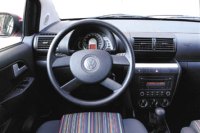|
 Fox
was evolved from Wolf. We are not talking about animals, of course, but
the smallest cars from Volkswagen. Since Volkswagen added Lupo (means
wolf in Italian) as its entry-level mini car in 1998, its success was
limited. The Lupo was one of the smallest cars in Europe. It was built
in Wolfsburg, VW's headquarters in Germany, with impeccable quality.
But the problem is the market doesn't need such an expensive mini car.
Budget buyers chose the Korean cars, Japanese cars and Fiat instead,
leaving Lupo to be a niche player. Fox
was evolved from Wolf. We are not talking about animals, of course, but
the smallest cars from Volkswagen. Since Volkswagen added Lupo (means
wolf in Italian) as its entry-level mini car in 1998, its success was
limited. The Lupo was one of the smallest cars in Europe. It was built
in Wolfsburg, VW's headquarters in Germany, with impeccable quality.
But the problem is the market doesn't need such an expensive mini car.
Budget buyers chose the Korean cars, Japanese cars and Fiat instead,
leaving Lupo to be a niche player.
After 7 years, VW finally gave up. It switched to source from its
Brazilian arm, import a mini car back to Europe. This is Fox.
That's why Fox is not actually a car designed and built to European
standard. It was originally designed to satisfy Latin America buyers
(there are lots of them there, although we usually overlook). Not
exactly poorly built, but it falls short of the standard of other
Volkswagen group products. Compare to the Lupo, you can easily see its
interior plastics and trimming are cheap, while the dashboard styling
is workman-like. It brings you back to reality.
Nevertheless, the Brazilian-built Fox is cheaper than the Lupo yet
offers considerably more space. In fact, its body is a size up,
actually matches Polo. No, it is even taller than Polo by 80mm. This
enables an elevated seating as well as abundance of headroom.
Naturally, the rear seat is more accommodating than the
ultra-short-wheelbase Lupo. It is best suited to children, but adults
won't complain for short journey either. However, its rear seat space
is not as generous as Korea cars like Hyunda Getz, Kia Picanto and
Daewoo Kalos.
 In
contrast, luggage capacity is more generous. As the rear seat is
mounted on rails and can slide back and forth for 150 mm, cargo room
can vary from 260 to 350 litres. This expand to 1016 litres when the
rear seat folds down. In
contrast, luggage capacity is more generous. As the rear seat is
mounted on rails and can slide back and forth for 150 mm, cargo room
can vary from 260 to 350 litres. This expand to 1016 litres when the
rear seat folds down.
The Fox looks conservative from outside. Its chassis doesn't excite
either. The standard Volkswagen group layout - front MacPherson strut
and rear torsion-beam axle suspensions. The standard Volkswagen tuning
- good grip, predictable but understeer moderately when it rush into
corners. However, its suspensions are set quite soft and has long
travel - designed to deal with the poor roads in Latin America - thus
generate excessive body roll. Apparently, Fox is not designed for
driving fun.
The engines also lack sparkle. Fox employs a 1.2-litre 3-pot and
1.4-litre 4-pot petrol engine like Polo, but they are cheapened
versions. The 1.2 runs old-fashion 2 valves per cylinder and produces
only 54 horsepower. The 1.4 has lost FSI direct injection which found
in Polo, hence producing only 75 horsepower. Although both engines are
torquey, they don't have enough power for overtaking.
So, Wolf to Fox is a backward evolution. When quality and fun factors
no longer exist in a Volkswagen, why don't us simply buy an even
cheaper Korean car? |